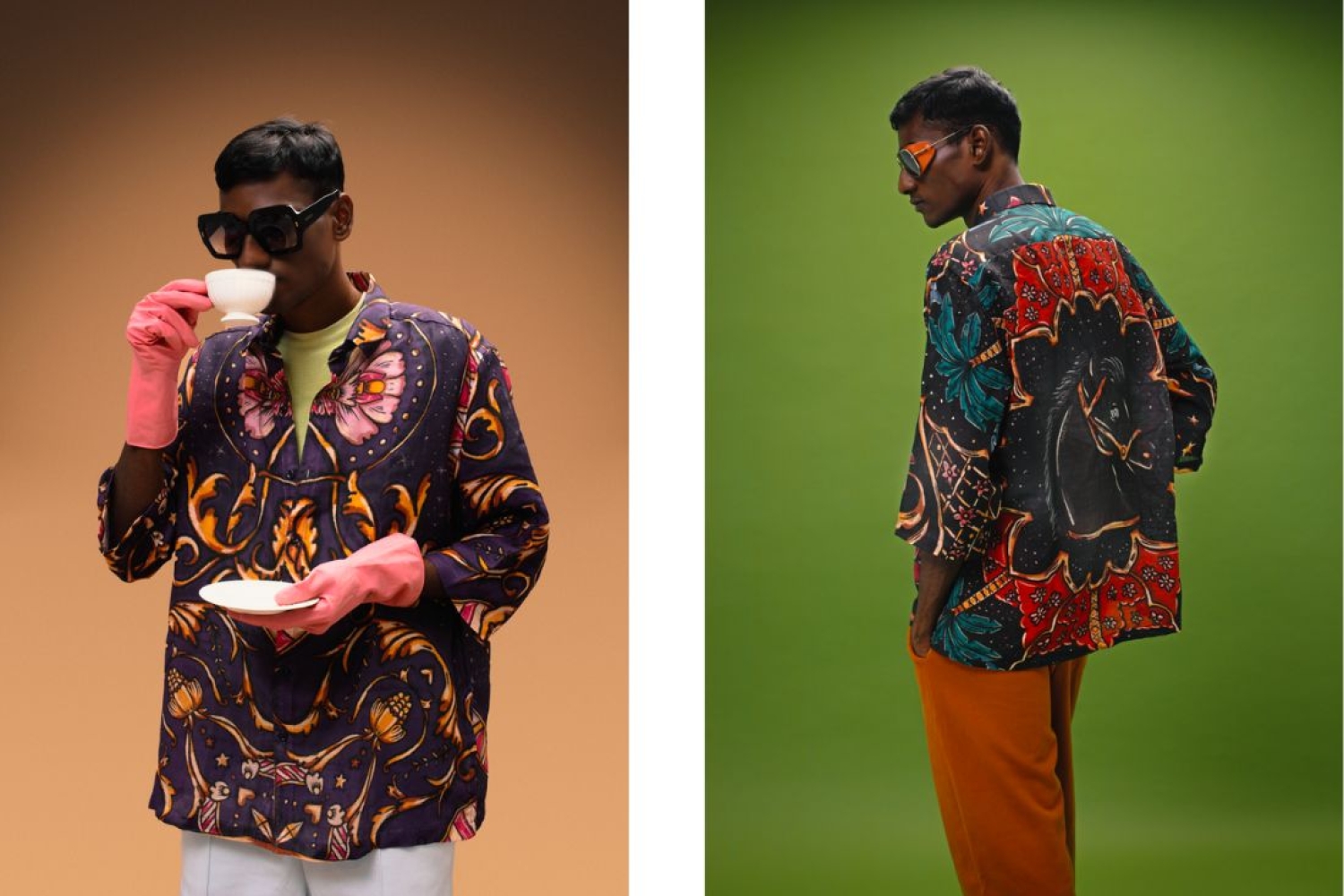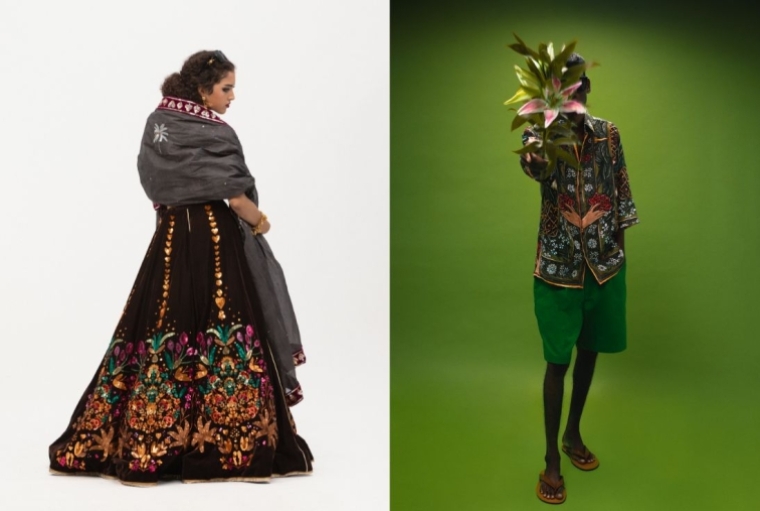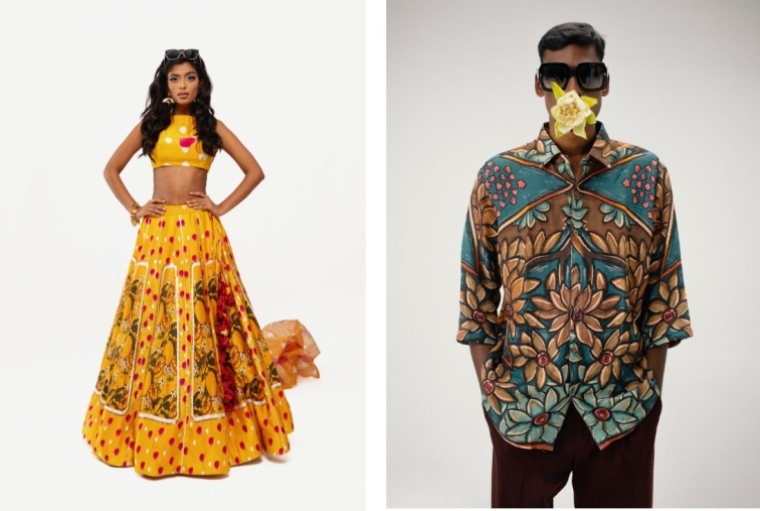
Photography credits: Debarati Sanyal

Photography credits: Debarati Sanyal
Aishwarya Ravichandran's illustrative art finds its expression in the fabric of her brand, Aishr. Drawing inspiration from the rich emotions and vibrant colors of Indian culture, Aishr creates designs that are veritable works of art. The journey began when Aishwarya, fueled by the desire to wear her own creations, started drawing directly on her clothes as a child. However, the process wasn't immediately clear to her at that young age. Over time, this practice evolved into a distinctive approach where Aishwarya realized she could transform her illustrations into wearable pieces by translating them into prints.
The exploration of various techniques and prints became a natural progression, leading her to discover a newfound interest in the intersection of fashion and art. Currently, her focus lies on delving into the realm of embroideries, seamlessly blending the worlds of fashion and art into the fabric of her clothing. We talk to her to know more about her as well as the brand's journey.
How did the concept of creating a brand like Aishr come about?
Well, the idea of Aishr has always been a dream of mine, evolving over time into what it is today. The essence of Aishr revolves around themes of peacefulness, vibrant colors, and conveying meaningful messages. The entire concept centers on two primary messages. Firstly, for the wearer, it's about expressing genuine enjoyment, carrying oneself with confidence, and making a statement that they don't need to conform to being quiet and subtle. Instead, they can stand out from the crowd. Wearing Aishr is like showcasing a vibrant, colorful piece that immediately catches attention, encouraging individuals to stand out boldly.
The second message emphasizes that fashion is a form of art seamlessly blending into everyday life. The aim is to inspire people to view themselves as unique pieces of art, transforming daily life into a canvas. It's an encouragement for individuals to embrace their distinctive style, presenting themselves as walking masterpieces—a fun way to celebrate their uniqueness.

Photography credits: Palak Rungta (left) | Debarati Sanyal (right)
Tell us about your design sensibilities.
If you examine most of the collections I've previously crafted, they draw inspiration from my surroundings. Specifically, my hometown, Chennai, and the broader context of Tamil Nadu in the southern region of India. The South, in general, is rich in colors, adorned with vibrant floral markets and an array of captivating elements. My inspirations stem from the vivid colors, intricate patterns, and the diverse array of objects in this environment. Additionally, I draw concepts from popular discussions within my local city. Take, for instance, my Zodiac collection—it's inspired by a prevalent and engaging topic in Chennai, where discussions about astrology and zodiac signs are widespread.
What fascinates me is that these discussions, originating in my city, transcend local boundaries and become global hot topics. People from various countries engage in conversations about them, each contributing their unique cultural perspectives. For example, my exploration extended to the Chinese zodiac signs, resulting in shirts inspired by the animals but infused with a touch of Indianness. The goal is to blend two different cultures while maintaining a modern and contemporary aesthetic.
Essentially, my approach to designing collections involves a harmonious fusion of the old and the new. Culture, in my perspective, is not confined to traditional practices but involves borrowing from the past while ushering in innovations for the present generation. It's about crafting designs that reflect the spirit of today while embracing the rich cultural tapestry of yesterday.
How do you implement zero waste and sustainable practices in your brand?
When I initially conceptualized my brand, the commitment to sustainability was paramount. Recognizing the considerable environmental impact of the fashion industry, I was driven by the belief that it was essential to address issues detrimental to the economy, the planet, and the well-being of those involved in the production process.
In my early years, I associated sustainable fashion with subdued colors and simpler designs, perceiving it as somewhat dull. However, as my involvement in the industry deepened, I realized that sustainability goes beyond color choices and manufacturing processes. It encompasses ensuring that the pieces endure for an extended period.
To uphold sustainability, we collaborate with vendors certified by organizations such as GOTS, verifying their adherence to sustainable practices in fabric processing. It's crucial to substantiate claims of sustainability with legitimate certifications rather than merely using the term loosely.
Sustainability isn't synonymous with monotony; it can be vibrant, engaging, and fashionable. Our garments embody these qualities, designed to endure beyond fleeting fashion seasons. We encourage customers to invest in pieces that resonate with them on a personal level, promoting a connection that transcends temporal trends. The goal is for customers to view these pieces as timeless, something they cherish and potentially pass down to future generations.
In addition to fabric processing, the construction of garments plays a pivotal role in sustainability. The durability and longevity of an outfit depend on the quality of materials and craftsmanship. Emotional value also contributes to sustainability, as a sentimental connection fosters responsible ownership and care. Furthermore, we embrace a zero-waste approach by repurposing fabric remnants into various items, such as bags and cushion covers. Our commitment extends to sustainable packaging, using reusable boxes for customers to store dry waste products. Cotton ribbons replace cello tape, promoting reusability. However, I emphasize that for a brand to be truly sustainable, both the brand and the consumer must practice sustainable habits. It's a collective effort to ensure that the lifecycle of a garment aligns with eco-friendly principles, from production to end-of-life disposal.

Photography credits: Palak Rungta (left) | Debarati Sanyal (right)
Art can be clothing but how can clothing be art?
The intricate processes involved in crafting garments, such as stitching and embroidery, are inherently artistic. Fabrics, with their unique textures and patterns, serve as beautiful canvases. Particularly in India, clothing represents pieces of exceptional craftsmanship, each telling a story of skill, passion, and the dedicated individuals behind their creation.
Collecting clothing as wearable masterpieces is a concept worth embracing. Beyond merely acquiring expensive or unique pieces, it's about curating a collection that narrates more than just the outfit itself. It reflects the craftsmanship, the passion poured into its creation, and the individuals who contributed to it. Owning such pieces becomes a memorable experience, and it encourages a shift towards viewing clothing as a form of art.
When you wear garments adorned with intricate embellishments or unique detailing, it becomes a celebration of life. It's a deeply personal and beautiful connection, knowing that significant time, effort, and thoughtful consideration went into the creation of that piece. Unlike traditional art that you hang on a wall, clothing allows you to embody and express art in a tangible and wearable form. It's not just something you own; it's something you can actively incorporate into your daily life, making the appreciation of clothing as an art form a uniquely enriching experience.
Words Paridhi Badgotri
Date 28.11.2023